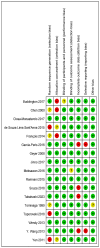Fructooligosaccharides for Relieving Functional Constipation: A Systematic Review and Meta-Analysis of Randomized Controlled Trials
- PMID: 39766936
- PMCID: PMC11675838
- DOI: 10.3390/foods13243993
Fructooligosaccharides for Relieving Functional Constipation: A Systematic Review and Meta-Analysis of Randomized Controlled Trials
Abstract
Fructooligosaccharides (FOS) are prebiotics with great potential to improve constipation. This study set out to investigate the usefulness of consuming FOS as a dietary supplement on bowel movement frequency, stool consistency, abundance of Bifidobacteria, gastrointestinal transit time, and gastrointestinal symptoms through a systematic review and meta-analysis of randomized controlled trials (RCTs). We searched the Cochrane Library, PubMed, EMBASE, and Web of Science databases up to 2 March 2024. Randomized controlled trials reporting the use of FOS as a supplement by participants were included. Bias risk was assessed using the Cochrane Risk of Bias assessment tool. Results were synthesized using a random-effects model or fixed-effects model, combining outcomes using odds ratios (OR), weighted mean differences (MD), or standardized mean differences (SMD) with 95% confidence intervals (CI). The meta-analysis encompassed 17 randomized controlled trials, involving a total of 713 study participants. Overall, the intake of FOS significantly increased bowel movement frequency (95% CI: 0.80, 1.50, p < 0.00001) and positively affected stool consistency, softening the stool (SMD: 0.36, 95% CI: 0.12, 0.60, p = 0.76). It also reduced the effort and pain during defecation (SMD: -0.60, 95% CI: -0.85, -0.34, p = 0.12). At the same time, mild bloating was noted as an adverse event associated with FOS ingestion (OR: 10.36, 95% CI: 3.32, 33.23, p = 0.24). No reports of serious adverse events were documented. Overall, FOS may enhance bowel movement frequency, stool consistency, and overall constipation symptoms, suggesting cautious optimism regarding their use as a dietary treatment alternative. Nevertheless, further robust and definitive randomized controlled trials are required to more accurately determine the most effective dosage and duration of use. Additional research and evidence are necessary before the efficacy of FOS as a therapeutic method for treating functional constipation can be firmly established.
Keywords: constipation; fructooligosaccharides (FOS); gut microbiota; meta-analysis.
Conflict of interest statement
The authors declare no conflicts of interest.
Figures









References
-
- Markland A.D., Palsson O., Goode P.S., Burgio K.L., Busby-Whitehead J., Whitehead W.E. Association of Low Dietary Intake of Fiber and Liquids With Constipation: Evidence From the National Health and Nutrition Examination Survey. Am. J. Gastroenterol. 2013;108:796–803. doi: 10.1038/ajg.2013.73. - DOI - PMC - PubMed
-
- Chan A.O., Cheng C., Hui W.M., Hu W.H., Wong N.Y., Lam K.F., Wong W.M., Lai K.C., Lam S.K., Wong B.C. Differing Coping Mechanisms, Stress Level and Anorectal Physiology in Patients with Functional Constipation. World J. Gastroenterol. 2005;11:5362–5366. doi: 10.3748/wjg.v11.i34.5362. - DOI - PMC - PubMed
-
- Parthasarathy G., Chen J., Chen X.F., Chia N., O’Connor H.M., Wolf P.G., Gaskins H.R., Bharucha A.E. Relationship Between Microbiota of the Colonic Mucosa vs Feces and Symptoms, Colonic Transit, and Methane Production in Female Patients With Chronic Constipation. Gastroenterology. 2016;150:367–379.e1. doi: 10.1053/j.gastro.2015.10.005. - DOI - PMC - PubMed
Publication types
Grants and funding
LinkOut - more resources
Full Text Sources
Molecular Biology Databases

